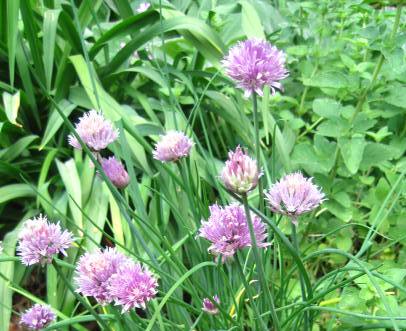Herbalishious!
If you planted some herbs soon after my last post, some of them might be ready for picking by now.
Here are a few tips and ideas for using and preserving herbs:
*Lightly crush a sprig of mint and add to a pitcher of tea or lemonade. Use a fresh leaf for garnish. And don’t forget my recipe for mint juleps a few posts ago!

*Mix chopped dill and minced cucumber into sour cream for an excellent sauce for salmon. Add salt and pepper to taste.
*Chop tarragon, chives or rosemary finely and mix with softened butter. Use to top grilled meats, poultry, fish or vegetables.
*For a warm twist on a caprese salad, top a thick tomato slice with basil leaves and a slice of fresh mozzarella. Bake in the oven until warm and cheese just begins to melt.
*Stuff the cavity of an oven-stuffer roaster with a lemon cut in half, a few whole garlic cloves and a bunch of oregano. Roast low and slow for tender Greek-style chicken.
*Slice an English cucumber into a colander set over a bowl. Salt the slices and allow water to drain for several hours. Discard water. Mix cucumber with finely minced fresh rosemary, seedless red or black grapes (cut in half) and a big splash of white balsamic vinegar. Delicious, light and healthy!

*Chive blossoms are edible and look beautiful atop a creamy tomato or potato soup.
*Add chopped tarragon to chicken or tuna salad.
*Chopped mint added to meatballs is wonderful!
*When cooking with fresh thyme, (an absolute must in most soups and stews) there is no need to tediously remove the tiny leaves from the stem. Just toss in the whole sprig. The leaves will fall off during cooking. Remember to remove the bare stem before serving.
*To make basil chiffonade, stack leaves, roll together, and slice across the roll thinly. This preparation method is called for frequently in recipes.
Herbs to dry – oregano, sage, tarragon, thyme, mint, rosemary. Most herbs with woody stems are best preserved by drying. A couple of hours before harvesting, give herbs a good shower with the garden hose. Allow the sun to dry them completely. Then cut stems and gather into small bunches. Wrap stems tightly with rubber bands. The rubber bands will stay tight as the stems dry and shrink.
Hang bunches upside down in a cool place with good air circulation. Door and cabinet knobs or a rod in an unused shower are all good places. Most herbs will be dry in 2 – 3 days. To remove leaves, place a large piece of butcher paper or paper towels on the kitchen counter and crush leaves gently over the paper. Remove pieces of stems. Now fold the paper to make it easy to pour the leaves into small jars or plastic bags. Be sure to label the containers because once dry, herbs are harder to identify. Dried herbs are more concentrated in flavor, so use less than you would if you were using fresh.

Herbs to freeze – chives, basil, dill, cilantro, parsley. Most tender, non-woody herbs are best preserved by freezing. Make sure herbs are dry after their shower (see above). Then, just pop them into freezer bags and place in the freezer. Once frozen, you can easily “mince” these herbs by gently crushing the bag.
You can also make batches of pesto with any over abundance of herbs. Freeze the pesto in ice cube trays. Wrap the filled trays with plastic wrap. One cube is about one serving. Frozen pesto lasts at least one year. (More on making pesto and recipes for using it later in the summer.)
Once you start using herbs to flavor your foods, you may find that you need less salt. In addition, herbs, being leafy green plants, also provide a multitude of nutritional benefits. You will quickly learn which herb is best for a particular use and how much to use for your taste, but don’t be afraid to experiment! You may find some unexpected delicious combination. Enjoy!













Leave a Reply
You must be logged in to post a comment.